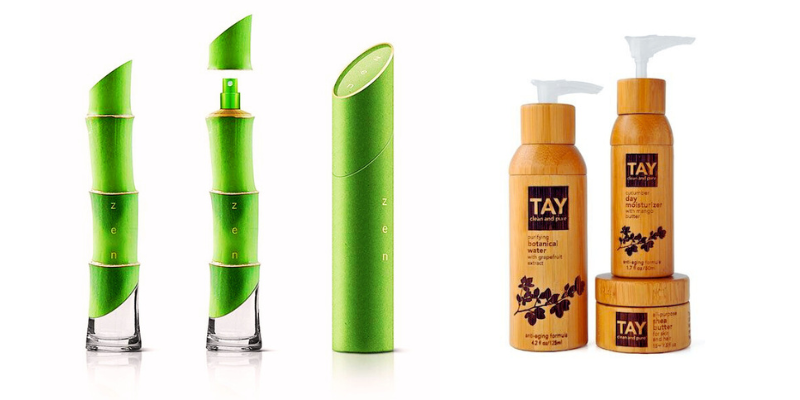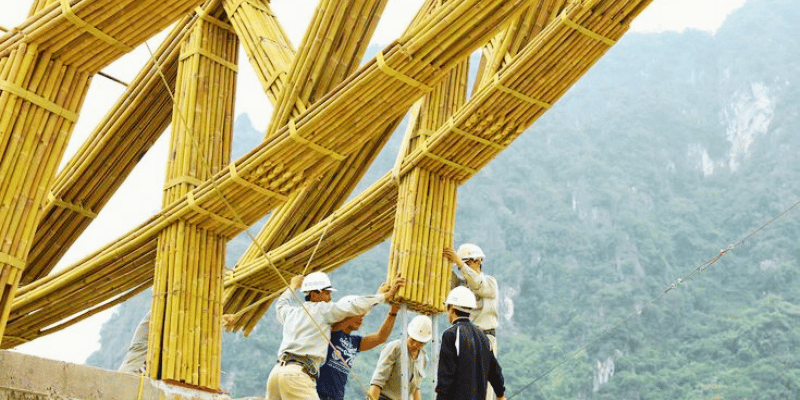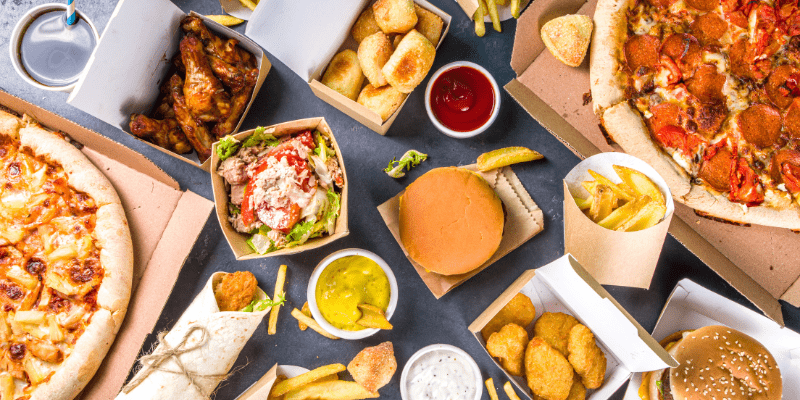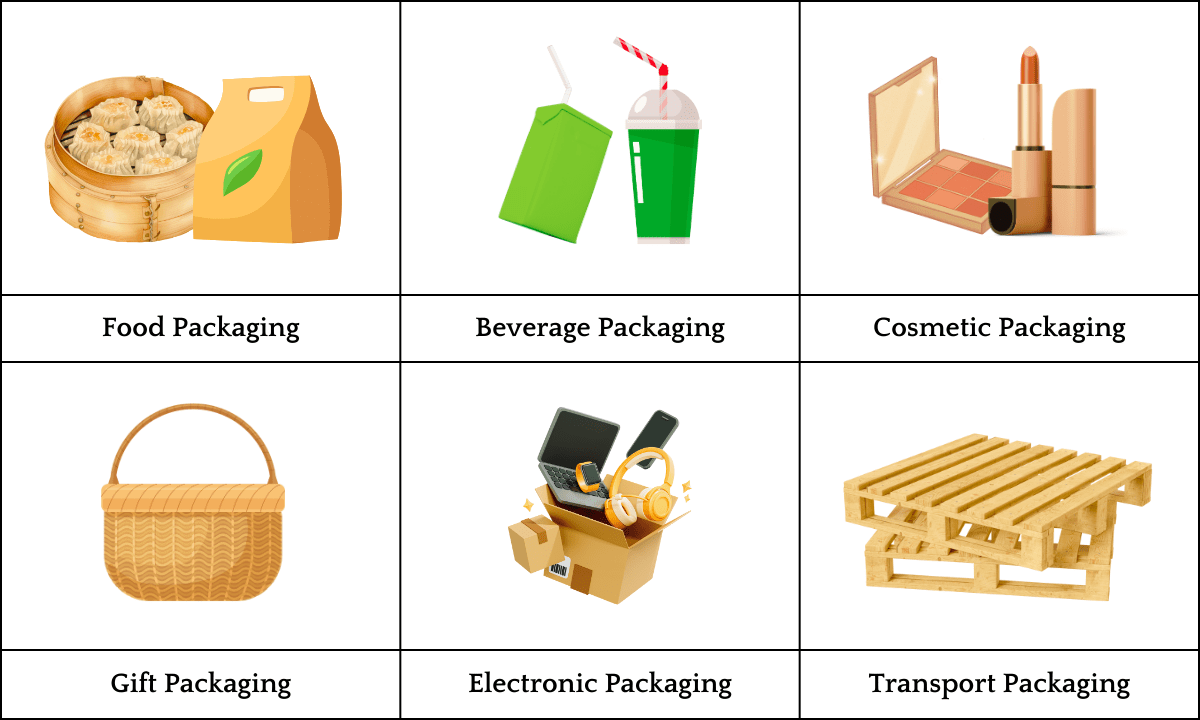
Bamboo packaging is gaining popularity as a sustainable solution due to its eco-friendly, renewable, biodegradable and versatile nature.
Bamboo is one of the fastest-growing plants on Earth that requires less water and no pesticides to grow, which is making them one of the best sustainable materials.
Unlike plastic, which is taking hundreds of years to decompose, bamboo can compost within a 6 months under optimum condition. In compost heap, bamboo can biodegrade or compost from 1-2 years depending on their species and size.
Plastic packaging is creating significant environmental issues. The production and consumption of plastic have increased exponentially since the mid-20th century because of its cheap production costs, versatility and durability.
At present, plastic pollution has reached at its alarming levels. Every year millions tons of plastics are ended in ocean and land, which are affecting marine life, ecosystems and human health.
As an awareness and apprehension towards climate change and global warming, both consumers and companies are taking interest in sustainable packaging.
What is sustainable packaging?
Sustainable packaging refers to the design, production and use of packaging materials that minimize environmental impact throughout their lifecycle while still effectively protecting and presenting products.
Table of Contents
Introduction

There are more than 1,500 known species of bamboo, belonging to 75 genera all over the globe, among these 75 genera, India has 23 genera with 125 species.
Examples: Dendrocalamus strictus, Bambusabambos, Bambusanutans, Bambusatulda, Dendrocalamus giganteusand etc.
What is bamboo packaging?

Bamboo packaging refers to the use of packaging materials derived from bamboo fibers or products made primarily from bamboo, bamboo pulp or bamboo powder for storage, transportation and sale.
Bamboo packaging offers a sustainable alternative to conventional packaging materials such as plastic, metal, paper, cotton and cardboard.
The worldwide bamboo packaging market is projected to reach a value of US$ 511 million by 2023 and is expected to grow at a compound annual growth rate (CAGR) of 6.4%, reaching US$ 950.3 million by 2033.
How bamboo became a best sustainable material?
Bamboo is widely recognized as a sustainable material for several reasons.
1. Rapid Growth Rate
The growth rate is so fast that some bamboo species can grow up to 32 inches in a day. These allows bamboo to grow and mature within 3-5 years.
So it can be harvested quickly as compare to other woody material for packaging purpose.
2. Renewable Resource
Bamboo is a renewable resource because it is a type of grass rather than a tree.
Unlike hardwood trees, which are taking few decades to mature, bamboo can reach maturity within 3 to 5 years.
After harvesting, bamboo can regrow fast from its existing root without planting it again.
3. Minimal Environmental Impact
Bamboo cultivation does not require pesticides, fertilizers and other chemicals as compared to other conventional crops or trees.
Use of fertilizers and pesticides leads to environmental issues, such as soil degradation, water pollution and air pollution.
Soil Degradation
Pesticides: While pesticides are designed to control pests and weeds, they can also harm beneficial organisms in the soil such as earthworms, mycorrhizal fungi and Rhizobium bacteria.
These beneficial organisms play crucial roles in maintaining soil structure and its health.
Fertilizers: Excessive use of fertilizers can lead to imbalance of nitrogen and phosphorus in soil. This imbalance can alter the soil pH and reduce soil fertility over time.
Water Pollution

Pesticides: Pesticides can pass through the soil and contaminate groundwater, rivers, pond and streams.
Moreover, runoff from agricultural farms can carry pesticides into nearby rivers or pond and posing risks to aquatic ecosystems and human health.
Fertilizers: Excess nutrients from fertilizers, particularly nitrogen and phosphorus, can also leach into water bodies.
This can cause eutrophication (excessive growth of plant on water surface). Eutrophication affects aquatic life by reducing oxygen level.
Air Pollution
Fertilizers: Nitrogen-based fertilizers can volatilize into the atmosphere as ammonia (NH3) or nitrogen oxides (NO).
Apart from reducing above negative impact on environment, bamboo can prevent soil erosion and improve soil health through its deep and extensive root system.
4. Biodegradability
Bamboo is considered as a biodegradable material due to its organic composition and natural break down process.
Organic Composition: Cell wall of bamboo consist of cellulose, hemicellulose and lignin.
Natural Break Down Process: Process of biodegradation begins, when it comes in contact of moisture, oxygen and microbes at a time.
Microorganisms takes up the organic matter of bamboo and breaking them down into simpler compounds, which can be absorbed by plants and other organisms.
Decomposition of Bamboo
The decomposition of bamboo can vary depending on several factors, including environmental conditions, size of the bamboo pieces and microbial activity.
In natural conditions, bamboo can decompose within 1 to 2 years, breaking down into organic matter that enriches the soil and supports new plant growth. However, decomposition can be accelerated within 6 months under controlled condition.
In certain cases, treated bamboo may take longer to decompose due to added chemicals or processing methods.
Bamboo decomposition begins with the breakdown of its organic matter, primarily cellulose, hemicellulose and lignin.
1. Microbial Decomposition
By secreting an enzyme, bacteria can break down bamboo into simpler compound.
Fungi, including both decomposers and symbiotic mycorrhizal fungi, also contribute to bamboo decomposition.
2. Moisture and Oxygen
Moisture and oxygen requires for microbial activity. Bamboo’s porous structure facilitates the penetration of moisture and oxygen for microbial growth.
As water pass through bamboo tissues, it hydrates microbial cells and enables enzymatic reactions.
Similarly, oxygen diffuses through bamboo’s fibrous matrix and supporting aerobic decomposition processes.
3. Temperature and Climate
Ambient temperature influences the rate of bamboo decomposition. Warmer climates accelerate microbial activity, promoting faster decomposition rates.
In tropical regions, high temperatures and humidity levels expedite the breakdown of organic matter.
While in cooler climates, decomposition may proceed more slowly due to reduced microbial activity.
As bamboo decomposes, it releases nutrients and organic matter back into the soil, which can improve soil health.
However, the decomposition of bamboo can also be influenced by external factors such as soil pH, nutrient availability and the presence of toxins or inhibitors.
Certain bamboo species may contain allelopathic compounds that inhibit microbial growth or deter herbivores, affecting decomposition rates and soil microbial communities.
Carbon Sequestration Capabilities of Bamboo

Bamboo is known for its remarkable carbon-absorbing capacity due to its rapid growth rate and high biomass production, which helps to mitigate climate change and global warming effect.
It has been reported that bamboo can absorb two times more CO2 from the atmosphere as compare to other plants or trees.
| Carbon Absorption Capacity of Bamboo | Carbon Absorption Capacity of Other Tree |
| 12 metric tons of CO2 per hectare per year | 6-8 metric tons of CO2 per hectare per year |
Photosynthetic process of bamboo releases oxygen as a byproduct and released oxygen is 35% higher than other plants or trees.
Bamboo’s specific carbon absorption rate can vary based on their species, age and environmental conditions, but still it exhibits impressive carbon sequestration capabilities.
Comparison of bamboo with other plants or trees in terms of carbon intake.
Growth Speed
Bamboo is well known for its rapid growth. Its certain species can grow up to 32 inches in a day.
This accelerated growth allows bamboo to absorb more carbon dioxide from the atmosphere as compared to other plants and trees.
High Biomass Production
Bamboo’s fast growth also results in high biomass production. As bamboo plants mature, they accumulate significant amounts of carbon within their stems, leaves and roots.
This biomass also serves as a carbon sinker.
Continuous Growth and Harvesting
Unlike some trees that reach maturity and stop growing, bamboo continues to grow and accumulate carbon throughout its life cycle.
Even after harvesting, bamboo can regrow fast from its existing root without planting it again.
In summary, bamboo’s carbon-absorbing capacity is significant due to its fast growth, high biomass production and continuous growth and harvesting cycle.
What is the relative strength of bamboo compared to steel?

Bamboo is well known for its impressive strength. It is much more stronger than traditional construction materials like wood, concrete and even some metals.
While it may not match with the absolute strength of steel in terms of tensile and compressive strength, bamboo exhibits remarkable strength.
Tensile Strength
Keep in mind that tensile strength of bamboo depend upon its species, age and processing methods.
| Strength of Bamboo (psi) | Strength of Steel (psi) |
| 28,000 – 48,000 (Pound-force per square inch) | 50,000 – 1,00,000 (Pound-force per square inch) |
Tensile strength of Guadua bamboo is reported more than 48,000 psi.
Compression Strength
Both bamboo and steel, showcases remarkable compression strength.
Bamboo’s unique structure and comprising fibers aligned along its length are the primarily reason for impressive strength.
| Strength of Bamboo (MPa) | Strength of Steel (MPa) |
| 40 – 80 (megapascals) | 250 – 400 (megapascals) |
Why bamboo is the best for food packaging?

Bamboo is often considered the best green alternatives for food packaging due to its unique antimicrobial, antifungal and hypoallergenic properties.
Bamboo food packaging provide an elegant, durable, renewable and fully compostable alternative to paper and plastic products.
There are many bamboo products available in market, such as utensils, tableware, bowls, plates, boats, cones, cups, skewers etc.
Antimicrobial Properties of Bamboo Kun
Bamboo has natural antimicrobial properties because of their bio component called “Bamboo Kun”, which means it can inhibit the growth of microorganisms.
Mainly food is spoiled or wasted, because of unexpected growth of microbes.
These antimicrobial properties helps to keep food fresh and safe for longer period.
Bamboo kun also helps to neutralize the odors by preventing the growth of odor-causing bacteria, which makes the food products odor resistant and fresh.
Antifungal Properties of Bamboo Kun
Bamboo kun also exhibits antifungal properties, which prevent the growth of fungi on bamboo.
Certain fungi produce mycotoxins, if ingested they can cause a range of health problems, including acute poisoning, organ damage and even cancer.
By using bamboo packaging, the risk of fungal contamination can be eliminated.
Natural Resistance
Bamboo has natural resistance towards the pests, weed and pathogens, which further enhances its suitability for food packaging.
In summary, unlike other materials that may require chemical treatments to remove pests, weed, fungi and microorganisms, bamboo’s inherent properties provide a more sustainable and environmentally friendly solution for food packaging.
Manufacturing of Bamboo Products
Bamboo powder can be effectively moulded to manufacture a wide range of bamboo products, including bottle, furniture, flooring, decking, panels and various decorative items.
1. Preparation of Bamboo Powder
Bamboo powder is obtained by grinding bamboo stems or other parts of the bamboo plant into a fine powder.
The bamboo material should be completely dried before grinding to ensure uniformity and prevent mold growth.
2. Mixing with Binders
Bamboo powder is mixed with binders to create a mixture that can be moulded into various size and shapes.
Common binders include resins such as phenolic resin, urea-formaldehyde resin or melamine-formaldehyde resin.
The binder helps to hold bamboo particles together and provides structural integrity to the final product.
3. Moulding Process
Compression Moulding: In compression moulding, the bamboo powder and binder mixture is placed into a mould cavity.
By applying heat and pressure, desire shape can be achieved.
Injection Moulding: Injection moulding involves injecting the bamboo powder and binder mixture into a mould cavity under high pressure.
The mixture fills the mould cavity and takes its shape.
Extrusion Moulding: In extrusion moulding, the bamboo powder and binder mixture is forced through a shaped die to produce continuous lengths of material with a specific cross-sectional shape.
4. Curing and Drying
After moulding, the bamboo products are cured and dried for hardening.
5. Finishing
Once the bamboo products are cured and dried, they may undergo additional finishing processes such as sanding, painting, staining or sealing to enhance their appearance and durability.
Top 5 Examples of Bamboo Products
Bamboo stands out as one of the most environmentally friendly material available today, so by using bamboo products, let’s free from plastic and adopt green lifestyle to save blue planet.
1. Bamboo Diaper
By nature, Bamboo diapers are hypoallergenic, which means they are less likely to cause allergic reactions in babies’ soft and sensitive skin.
Bamboo diapers have antimicrobial and antifungal properties, which means they can helps to keep baby’s skin healthy by fighting with harmful germs and fungi that could cause infections or rashes.
So, by using bamboo diapers, you can help to keep your baby’s skin happy and healthy while also doing something good for the environment.
2. Bamboo Toys
Bamboo toys offer a safer and more eco-friendly alternative to plastic toys, particularly for young children who are prone to chew their toys.
Bamboo is a natural material and does not contain harmful chemicals like phthalates, BPA and other toxic chemicals often found in plastic toys.
These toxic chemicals can leach out from plastic and pose health risks when children chewing toys.
Bamboo has natural antibacterial properties, which can helps to inhibit the growth of harmful bacteria on the surface of the toy, which can be beneficial, as children often put their toys in mouth.
3. Bamboo Bed Linen
Bamboo fibers are known for their softness, which makes bamboo bed linen exceptionally comfortable to sleep on.
Bamboo fibers have natural moisture-wicking properties, which helps to keep you cool and dry throughout the night.
Bamboo fibers are naturally hypoallergenic and resistant to dust mites, which is making bamboo bed linen a best choice for sensitive skin.
Bamboo fibers are long, strong and durable, so bamboo bed linen has a longer lifespan with premium look as compared to cotton bed linen.
4. Bamboo Flooring
Choosing Bamboo flooring for your home helps to create sustainable environment and greener planet.
Bamboo flooring is famous for its durability and strength. It is often harder than many hardwood species, such as oak or maple.
This means it is less susceptible for dents and scratches from everyday wear and tear.
Bamboo has natural moisture-resistant properties, which can make it more suitable for the moist areas, such as kitchens and bathrooms.
Bamboo flooring has same look and cost when compare with hard wood flooring like oak or mapple.
5. Bamboo Tableware and Cutlery
Bamboo tableware and cutlery is the best sustainable choice at big events and festivals, where lots of things are thrown away after using.
So, for occasions like Thanksgiving, birthday parties, Christmas, weddings and more, where you need disposable plastic plates and cutlery, bamboo tableware and cutlery could be the best option.
Let’s raise awareness about the harmful effects of plastic on the environment and the benefits of bamboo as a sustainable alternative.
Advantages of Bamboo Packaging
1. Sustainability
Bamboo is fast-growing plants on the Earth. Bamboo can be harvested quickly and sustainably without damaging environment.
2. Biodegradability
Unlike plastic packaging, which can persist in the environment for longer period, bamboo packaging is biodegradable or compostable.
3. Versatility
From food containers to cosmetic jars, bamboo packaging comes in various shapes and sizes, making it suitable for a diverse range of products.
4. Aesthetic Appeal
Bamboo’s tall, slender stalks, vibrant green leaves and distinctive segmented structure create a visually pleasing appearance.
5. Low Environmental Impact
Bamboo cultivation requires little water and no use of pesticides/fertilizers to grow. It helps to reduce the strain on natural resources and ecosystems.
Its extensive root system helps to prevent soil erosion and improve soil health.
6. Durability and Strength
Bamboo fibers are inherently strong and resilient, which can provide adequate protection during storage and transportation. It can standup up to 204 °C.
7. Carbon Sequestration
Bamboo plants absorb large amounts of carbon dioxide from the atmosphere and release 35 % more oxygen than same volume of other plants.
Applications of Bamboo Packaging

Bamboo packaging offers versatile applications across various industries like infrastructure, wooden flooring, textiles, craft, scaffolding, furniture and paper.
1. Food Packaging
Bamboo packaging is widely used for food packaging, including containers, trays, bowls, tableware and utensils.
2. Beverage Packaging
Bamboo can be molded into cups, mugs and bottles, providing durable and stylish alternatives to single-use plastic containers.
3. Cosmetic Packaging
Bamboo’s aesthetic appeal and natural texture enhance the visual presentation of beauty products such as, lipsticks and make-up kits.
4. Gift and Specialty Packaging
Bamboo gift boxes, baskets and packaging inserts offer eco-friendly alternatives to traditional paper or plastic packaging.
5. Electronic Packaging
Bamboo packaging can be customized to fit electronic devices and accessories, offering protective and environmentally friendly packaging solutions.
6. Shipping and Transport Packaging
Bamboo packaging is suitable for shipping and transport applications, including pallets and crates.
Bamboo’s strength and durability ensure the safe and secure transportation of goods while reducing reliance on conventional materials like wood or plastic.
Challenges of Bamboo Packaging
There are also several challenges and considerations that need to be addressed for its widespread adoption and effective implementation.
1. Cost
Bamboo packaging may have higher initial costs compared to conventional packaging materials like plastic or paper.
The production and processing of bamboo into packaging materials can be labor-intensive and require specialized equipment and patented molding technique, which may increase manufacturing expenses.
2. Supply Chain Management
Ensuring a reliable and sustainable supply of bamboo raw materials is essential for the smooth and continuous production of bamboo packaging.
Bamboo cultivation requires proper land management practices, adequate infrastructure and access to markets.
While bamboo is a highly sustainable material, transporting it from its country of origin to manufacturing facilities can have environmental implications, particularly if distances are long.
3. Standards and Certification
Establishing standards and certification system for bamboo packaging is important to ensure product quality, safety and compliance with regulatory requirements.
Certification programs such as Forest Stewardship Council (FSC) certification verify that bamboo is sourced from responsibly managed forests and adheres to environmental and social standards.
Innovations and Trends in Bamboo Packaging
Innovations and trends in bamboo packaging reflect a growing emphasis on sustainability, eco-friendliness and consumer demand for alternatives to conventional plastic packaging.
Here are some notable innovations and trends in bamboo packaging.
1. Biodegradable Coatings
Innovations in biodegradable coatings for bamboo packaging enhance appearance, moisture resistance, durability and shelf life.
Biodegradable coatings derived from natural materials such as plant-based polymers, beeswax and shellac provide effective barriers against moisture, oxygen, and contaminants.
2. Composite Materials
Composite materials combining bamboo fibers with biodegradable resins or polymers offer enhanced strength, flexibility and performance for packaging applications.
3. Advanced Manufacturing Techniques
Advances in manufacturing techniques for bamboo packaging enable the production of complex shapes, intricate designs and customizable features.
Accurate and precise fabrication can be done using a 3D printing, laser cutting and CNC machine.
Conclusion
In conclusion, bamboo packaging offers a compelling solution to the environmental challenges posed by plastics or conventional packaging materials.
With its rapid growth rate, renewability, low environmental impact and biodegradability, bamboo offers a sustainable alternative to the plastic packaging.
We cannot eliminate plastic usage completely at present, it is wise to minimize plastic consumption until more cost-effective and viable alternatives are discovered.
Frequently Asked Questions
Bamboo can absorb up to 2 times more carbon than similar tree species, making it an important tool in mitigating climate change and reducing greenhouse gas emissions.
Yes. Bamboo packaging products can be recycled to a certain extent, if they have not been chemically treated
Bamboo Kun is a natural antimicrobial and antifungal component found within bamboo fibers.
Bamboo grows much faster than trees. It requires less land and water to cultivate, making it more resource-efficient.
Additionally, bamboo regenerates quickly after harvesting without the need for replanting. Its deep root system also helps prevent soil erosion and improve soil health.
Furthermore, bamboo produces more oxygen and absorbs more carbon dioxide than trees, contributing to mitigating climate change.





